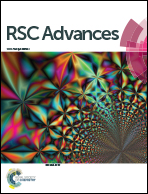Novel [NF2O]+ and [N3NFO]+-based energetic oxidizers for solid propellants with super high specific impulse
Abstract
Novel [NF2O]+ and [N3NFO]+-based energetic oxidizers were designed, and their structures, thermal stabilities, and energetic properties were investigated via density functional theory (DFT). The analysis of the bond dissociation energies (from 93.4 to 120.8 kcal mol−1) for the screened salts suggests that they possess better thermal stabilities than the reported [NF2O]+SbF6− (89.8 kcal mol−1), and compound 5 was the most stable energetic salt. All the screened salts possess a positive oxygen balance ranging from 13% to 50%. Due to a positive oxygen balance, the specific impulses of the compounds 5, 11–14 (>300 s) were superior to those of ammonium perchlorate (AP) and ammonium dinitramide (ADN) when the optimized ratio of oxidizer/aluminium/PBAN (%) was 76 : 10 : 14. Considering their thermal stability and chemical reactivity, compounds 5 and 11 with super high specific impulses can be regarded as excellent candidates for novel potential solid propellants.
![Graphical abstract: Novel [NF2O]+ and [N3NFO]+-based energetic oxidizers for solid propellants with super high specific impulse](/en/Image/Get?imageInfo.ImageType=GA&imageInfo.ImageIdentifier.ManuscriptID=C7RA03304D&imageInfo.ImageIdentifier.Year=2017)


 Please wait while we load your content...
Please wait while we load your content...